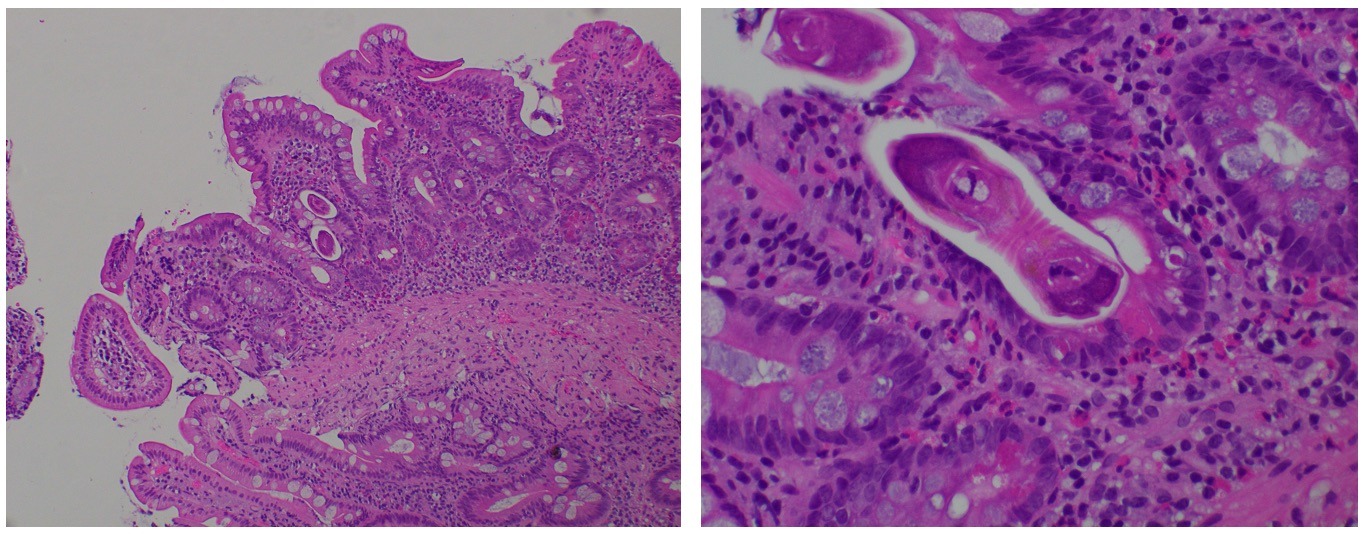Back
Poster Session E - Tuesday Afternoon
E0678 - Atypical Endoscopic and Clinical Presentation of Strongyloidiasis
Tuesday, October 25, 2022
3:00 PM – 5:00 PM ET
Location: Crown Ballroom

Austin R. Thomas, DO
University of Texas Health Science Center
Houston, TX
Presenting Author(s)
Austin R. Thomas, DO, Samantha S. Chung, MD, Sushovan Guha, MD, PhD
University of Texas Health Science Center, Houston, TX
Introduction: Strongyloidiasis is a helminthic parasitic infection caused by the nematode Strongyloides stercoralis. Due to its replication cycle within the human host, acute infection classically presents sequentially with skin irritation, dry cough, and then non-specific gastrointestinal (GI) symptoms. Mild GI and dermatologic symptoms appear to be more prevalent in chronic infections. Here we present a case of strongyloidiasis manifesting in atypical symptoms with normal endoscopic findings.
Case Description/Methods: An 81-year-old female with a medical history of diverticulosis, hypertension, type 2 diabetes mellitus, hypercholesterolemia, and chronic kidney disease was admitted to the hospital for anorexia, abdominal pain, and unintentional 26-pound weight loss over 6 months. Computed tomography of chest, abdomen, and pelvis revealed a moderate left-sided pleural effusion and uncomplicated sigmoid diverticulitis. Pleural fluid studies showed exudative features, with negative cultures and cytology. She was started on ciprofloxacin and metronidazole for diverticulitis. The patient also had a chronic iron deficiency anemia with an average hemoglobin of 7.4 g/dL. Absolute eosinophil count, total IgE, sedimentation rate, and c-reactive protein were elevated. Enteroscopy up to the mid jejunum appeared normal except for a 4 cm hiatal hernia. Random duodenal biopsies showed chronic active duodenitis with several eosinophils and parasitic organisms (Figure 1). Colonoscopy was deferred due to acute diverticulitis. Strongyloides serum antibodies were positive. Stool studies were not analyzed due to lab errors. The patient was treated with oral ivermectin 200 mcg/kg/day for 14 days due to concern for disseminated infection and scheduled for an outpatient endoscopy and colonoscopy.
Discussion: This case highlights the need to keep parasitic infections on the differential when patients present with symptoms concerning for malignancy, such as weight loss, anemia, abnormal laboratory markers, and new pleural effusions. While S. stercoralis has been found to mimic inflammatory bowel disease, it has not been associated with diverticulitis thus far. In addition, typical endoscopic findings include edematous and erythematous mucosa with white villi, however, this patient had normal endoscopic findings despite the extent of her infection. The duodenal biopsies aided in making the diagnosis for this case and should be considered in patients with similar presentations.

Disclosures:
Austin R. Thomas, DO, Samantha S. Chung, MD, Sushovan Guha, MD, PhD. E0678 - Atypical Endoscopic and Clinical Presentation of Strongyloidiasis, ACG 2022 Annual Scientific Meeting Abstracts. Charlotte, NC: American College of Gastroenterology.
University of Texas Health Science Center, Houston, TX
Introduction: Strongyloidiasis is a helminthic parasitic infection caused by the nematode Strongyloides stercoralis. Due to its replication cycle within the human host, acute infection classically presents sequentially with skin irritation, dry cough, and then non-specific gastrointestinal (GI) symptoms. Mild GI and dermatologic symptoms appear to be more prevalent in chronic infections. Here we present a case of strongyloidiasis manifesting in atypical symptoms with normal endoscopic findings.
Case Description/Methods: An 81-year-old female with a medical history of diverticulosis, hypertension, type 2 diabetes mellitus, hypercholesterolemia, and chronic kidney disease was admitted to the hospital for anorexia, abdominal pain, and unintentional 26-pound weight loss over 6 months. Computed tomography of chest, abdomen, and pelvis revealed a moderate left-sided pleural effusion and uncomplicated sigmoid diverticulitis. Pleural fluid studies showed exudative features, with negative cultures and cytology. She was started on ciprofloxacin and metronidazole for diverticulitis. The patient also had a chronic iron deficiency anemia with an average hemoglobin of 7.4 g/dL. Absolute eosinophil count, total IgE, sedimentation rate, and c-reactive protein were elevated. Enteroscopy up to the mid jejunum appeared normal except for a 4 cm hiatal hernia. Random duodenal biopsies showed chronic active duodenitis with several eosinophils and parasitic organisms (Figure 1). Colonoscopy was deferred due to acute diverticulitis. Strongyloides serum antibodies were positive. Stool studies were not analyzed due to lab errors. The patient was treated with oral ivermectin 200 mcg/kg/day for 14 days due to concern for disseminated infection and scheduled for an outpatient endoscopy and colonoscopy.
Discussion: This case highlights the need to keep parasitic infections on the differential when patients present with symptoms concerning for malignancy, such as weight loss, anemia, abnormal laboratory markers, and new pleural effusions. While S. stercoralis has been found to mimic inflammatory bowel disease, it has not been associated with diverticulitis thus far. In addition, typical endoscopic findings include edematous and erythematous mucosa with white villi, however, this patient had normal endoscopic findings despite the extent of her infection. The duodenal biopsies aided in making the diagnosis for this case and should be considered in patients with similar presentations.

Figure: Duodenal biopsies showing chronic active duodenitis with several eosinophils and parasitic organisms.
Disclosures:
Austin Thomas indicated no relevant financial relationships.
Samantha Chung indicated no relevant financial relationships.
Sushovan Guha indicated no relevant financial relationships.
Austin R. Thomas, DO, Samantha S. Chung, MD, Sushovan Guha, MD, PhD. E0678 - Atypical Endoscopic and Clinical Presentation of Strongyloidiasis, ACG 2022 Annual Scientific Meeting Abstracts. Charlotte, NC: American College of Gastroenterology.
